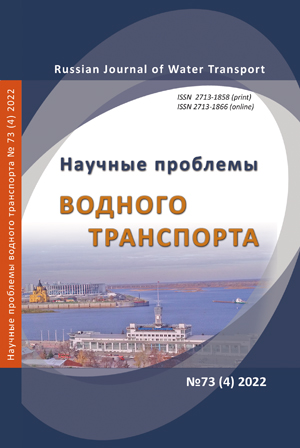The impact of the pandemic on the maritime transport of the Far Eastern region
Abstract
The current pandemic has dealt a serious blow to the global market of the transport and logistics system. With the closure of borders, a sharp decline in demand for goods, the growth of the dollar, the volume of cargo traffic at the local and global levels has significantly decreased. The usual logistics schemes in the conditions of the pandemic ceased to operate, and many logistics companies were on the verge of economic collapse. Maritime transport was one of the first to suffer from the pandemic. Working under difficult conditions and restrictions, he continued to carry out his functions for the transportation of goods and passengers. However, the scale of the pandemic in the maritime transport of the Far Eastern region has not yet been determined, and its consequences have not been fully studied. In this regard, the regularities of the development of the port industry and shipping in the Far Eastern region during the pre-pandemic and pandemic periods are investigated. The negative consequences of the impact of the pandemic on maritime transport have been studied, the reasons for the "lengthening" of project deadlines, reducing the number of ship trips to ports, and the problems of reducing passenger traffic, including cruise shipping, have been studied. It is concluded that the pandemic has had an indirect rather than a direct impact on the maritime transport of the Far Eastern region.
References
Минакир П.А. Экономика пандемии: российский путь // Пространственная экономика. 2020. Т. 16. № 2. С. 7–18. https://dx.doi.org/10.14530/se.2020.2.007-018
Семенихин Я.Н., Новосельцев Е.М. Ванино-Совгаванский транспортно-промышленный узел: возможности и реалии // Морские порты. 2020. № 3. С. 38-42.
Заостровских Е.А. Особенности развития угольных портов Дальнего Востока России // Регионалистика. 2020. Т. 7. № 1. С. 30-45. https://doi.org/10.14530/reg.2020.1.30
Гомилевская Г.А., Петрова Г.А. Морской туризм как составляющая туристского бренда «Восточное кольцо России» // Вестник Владивостокского государственного университета экономики и сервиса. 2017. № 3. С. 71-85. https://doi.org/10.24866/vvsu/2073-3984/2017-3/71-85
Заостровских Е.А. Устойчивое развитие круизного туризма в Дальневосточном регионе // Современные проблемы регионального развития. Материалы IX Всерос. науч. конф. Биробиджан, 24-26 мая 2022 г. / Под ред. Е.Я. Фрисмана. Биробиджан: ИКАРП ДВО РАН, 2022. С. 69-74. https://doi.org/10.31433/978-5-904121-35-8-2022-69-72
Музлова Г. Экспорт угля: азиатский вектор. Морские порты. 2021. № 3. URL: http://www.morvesti.ru/themes/1694/90265 (дата обращения: август 2022).
Головщиков В.О., Огнёв Д.В. Петрякова Е.А. Перспективы БАМа и Транссиба с учётом состояния регионов и развития угольной отрасли // Энергетическая политика. 2021. № 2. С. 30-43. https://doi.org/10.46920/2409-5516_2021_4158_30
Найден С.Н. Социальные эффекты от реализации инвестиционных проектов // Регионалистика. 2017. Т. 4. № 6. С. 28-33. DOI: 10.14530/reg.2017.6
Огай С.А., Луговец А.А., Затепякин С.М., Рычкова В.Ф. Состояние и перспективы развития портовой инфраструктуры Приморского края / Проблемы транспорта Дальнего Востока. Доклады научно-практической конференции. 2017. № 2. С. 504-511. https://doi.org/10.52376/978-5-907623-01-9_028
Зоидов К.Х., Медков А.А. «Шёлковый путь здоровья» – инновационно-инфраструктурная основа постпандемийного восстановления мировой экономики // Проблемы рыночной экономики. 2021. № 3. С. 179-195. DOI: https://doi.org/10.33051/2500-2325-2021-3-179-195
Lau Y.-y., Yip T.L. The Asia cruise tourism industry: Current trend and future outlook // The Asian Journal of Shipping and Logistics. 2020. № 36. P. 190-201. https://doi.org/10.1016/j.ajsl.2020.03.003
Буянов С.И. Обновление планов развития морских портов // Морские порты. 2021. № 1. С. 28-32.
Copyright (c) 2022 Russian Journal of Water Transport

This work is licensed under a Creative Commons Attribution 4.0 International License.













